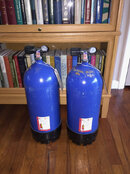I fill mine at home to 3800. Problem is many ow shops refuse to fill any tank beyond 3000 and often less.
I live in South FL. My HP100s are consistently filled to 3600-3900 psi. Since moving here, I've NEVER had them returned to me with anything less than 3500 psi. When I lived in Indiana I regularly had them returned to me with 3200-3300 psi, sometimes less. If I got a solid 3442 fill it was an exception.




